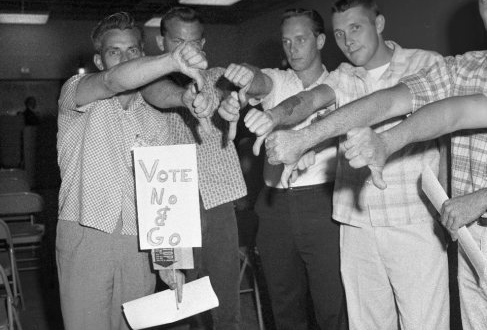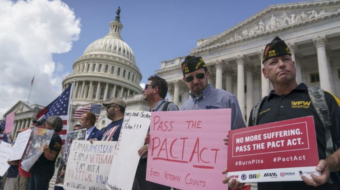
On this date in 1966, International Association of Machinists (IAM) members across the country employed by five airlines went on strike. For 43 days during the peak of the summer travel season, 60 percent of the U.S. commercial airline industry was shut down as 35,000 workers stayed out on the largest strike in airline history.
After several years of flat wages as the airline industry invested heavily in jet technology, aircraft mechanics and other ground service workers represented by the IAM were anxious to share in the substantial profits of 1965. Facing a bargaining impasse between the IAM and the five carriers (United, Northwest, National, Trans World and Eastern) covered in the industry’s first multi-carrier labor contract, a Presidential Emergency Board presented a “compromise” package that the workers rejected.
With U.S. involvement in Vietnam deepening, the Lyndon Johnson administration was strong-arming a voluntary 3.2 percent wage guideline to keep the economy from heating up. But despite the high skills needed by airline mechanics, their wage scales were significantly behind other industries. For some years airline profits were depressed by the huge capital outlays needed to bring the industry into the jet age.
The work force assumed that when the switchover from reciprocating to jet engines was complete, the carriers would share the profits made possible by greater productivity. By the mid 1960s those profits were enormous: In 1965, Eastern turned the previous year’s $5.8 million loss into a $29.7 million profit. United almost doubled its 1964 profit of $27.3 million, and the industry as a whole recorded a half billion dollar surplus. The Machinist graphically described the industry’s profits as having “whooshed into the jet stream.”
On July 8, almost a year after negotiations started, and more than six months after the old contract expired, IAM members began picketing 230 airports. From JFK to Honolulu, jet engines revved up for one last roar before gasping to final silence.
With cargo handlers, ramp service workers cleaners, storekeepers, inspectors, and food service workers joining mechanics on picket lines, the strike hit far, wide and deep. More than 150,000 daily airline passengers were forced to scurry around for trains, buses or rental cars. Airmail and air freight were delayed, and hotels, travel agencies, resorts and other businesses began to feel the pinch. In a move that bordered on government-sanctioned strike-breaking, the Civil Aeronautics Board announced that carriers still operating would be allowed to increase their service, and non-scheduled airlines would be permitted to lease planes from the five downed lines. The Transport Workers Union, representing thousands of workers on American and Pan Am, served notice that they would not perform any duties “not normally done prior to the strike” and would not work on any aircraft leased from the five struck carriers.
President Johnson brought negotiators to the White House, and on its 22nd day he announced a strike settlement calling for a 4.5 percent raise each year for three years. But over the weekend, angry machinists stormed local lodge halls to reject the settlement by a vote of 17,251 to 6,587.
Appalled by the prospect of a compulsory settlement, the union and the industry went back into an all-night session mediated by Assistant Secretary of Labor Jim Reynolds. They reached an agreement that was ratified, 17,721 to 8,235, on Aug. 19, 43 days after the strike began. The new contract provided for a 56¢ an hour raise for skilled workers, and average increase of 50¢ an hour for others. More importantly, it included a cost-of-living clause and substantial improvement in fringes. The final settlement worked out to six percent, considerably better than the president’s original 3.2 percent guideline, or even the 4.5 percent offered in the White House settlement.
Adapted from The Fighting Machinists, A Century of Struggle, by Robert G. Rodden, and other sources.










